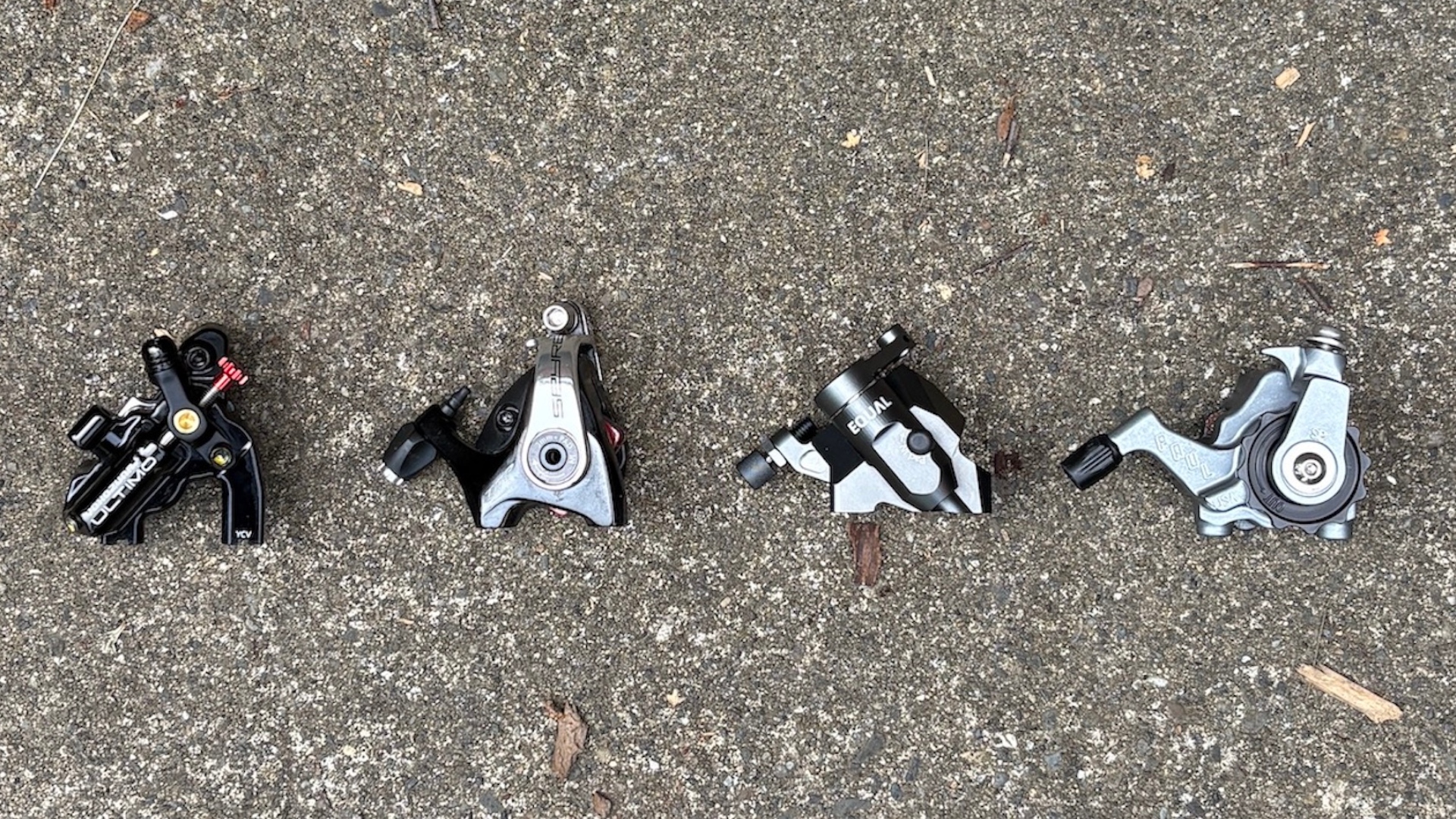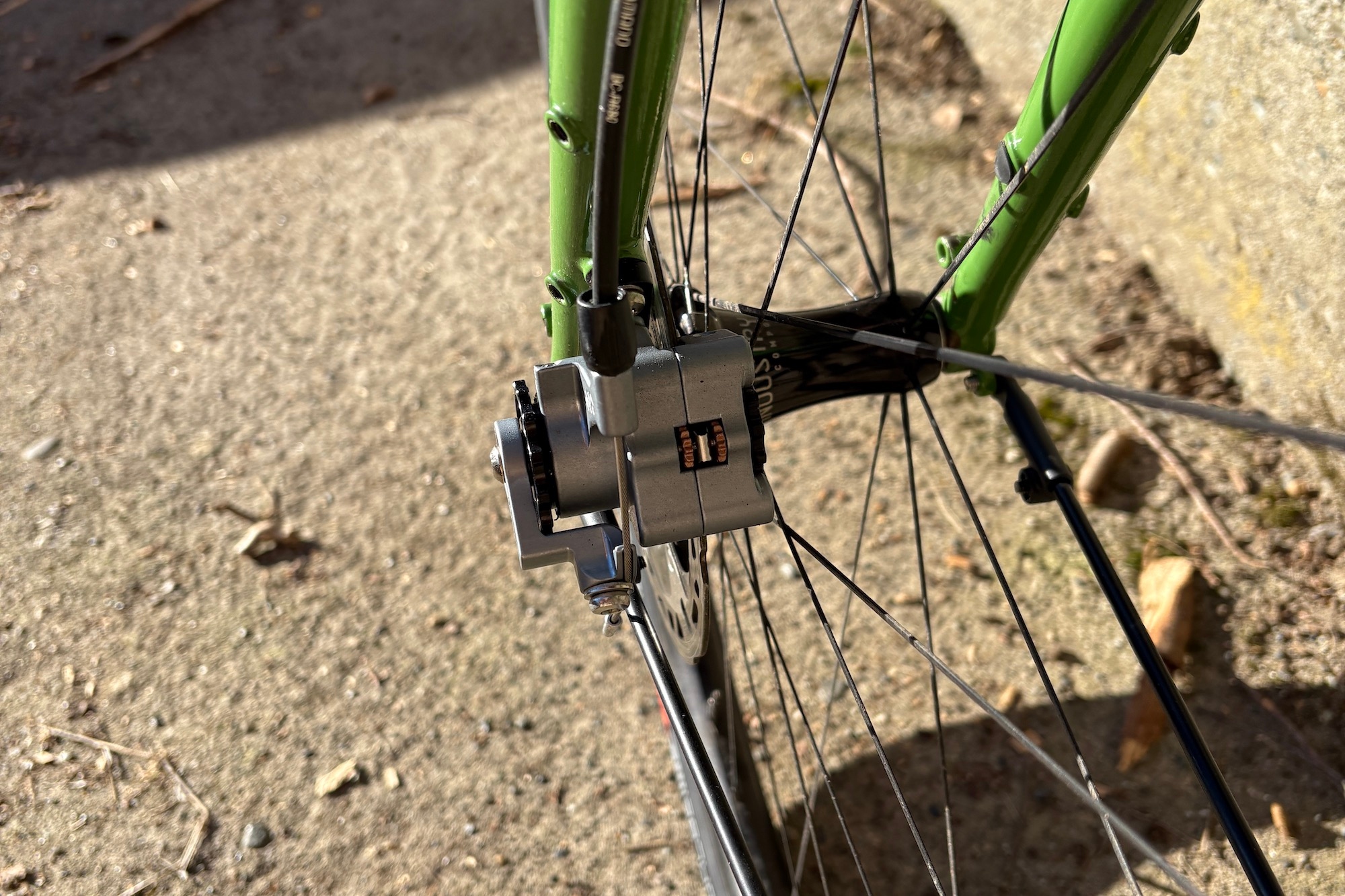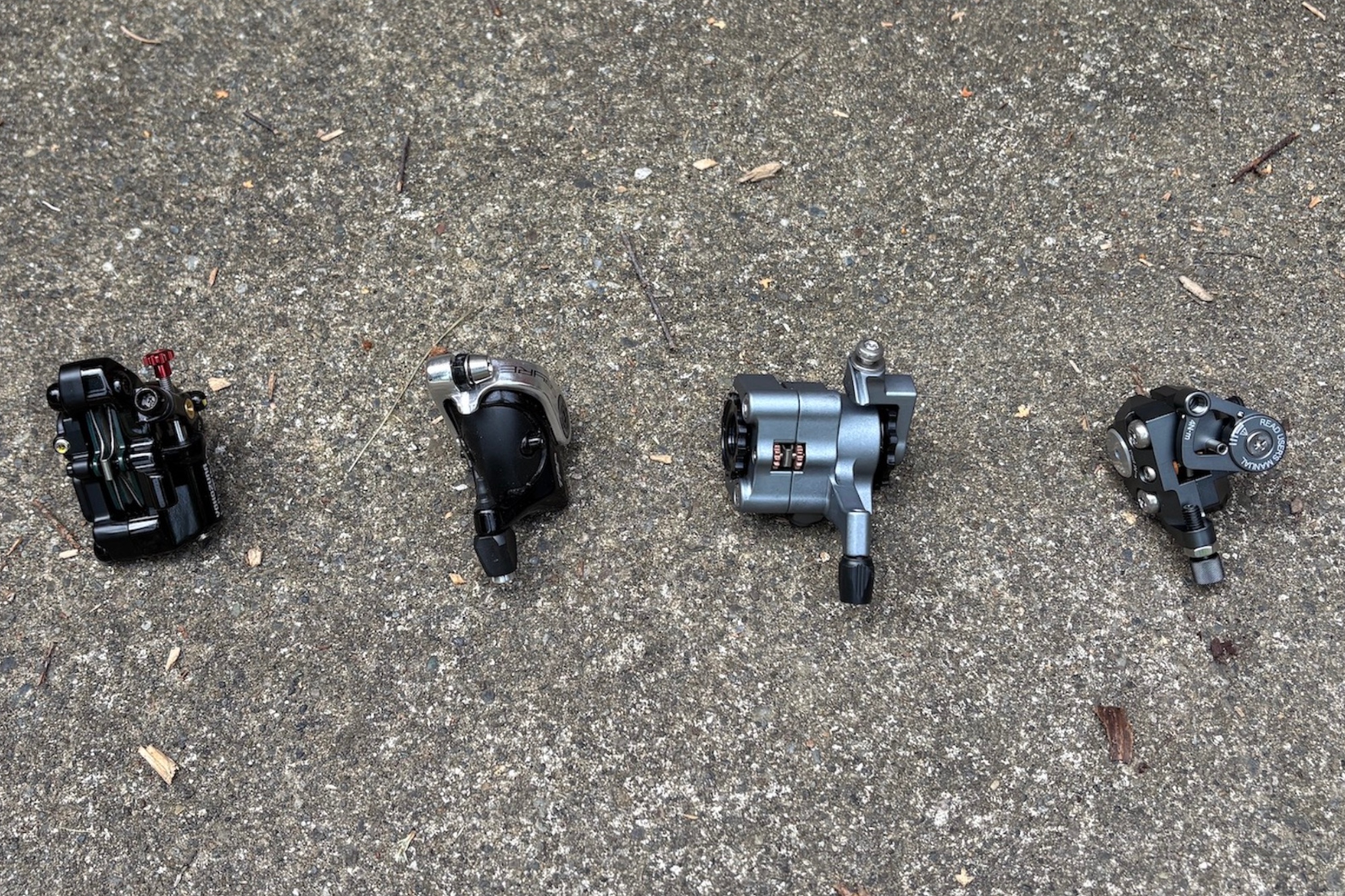Why would anyone choose cable disc brakes? We test four sets to see if they still have the stopping power we expect
Mechanical discs certainly claim to be an easier, more adjustable alternative to hydraulics, but does the lack of power outweigh their simplicity? To find out, I have put four market-leading options to the test.


Why would anyone choose cable-actuated disc brakes in 2025? It’s a fair question.
There’s a reason why hydraulic disc brakes have become the industry standard. Purely from a performance standpoint, they are superior to cable-actuated disc brakes. They are simply more efficient at transferring force from the lever to the calliper. Compared to mechanical systems, hydraulics offer better lever feel, braking power and modulation. Hydraulic systems can also self-adjust as the best brake pads wear down, helping to maintain consistent braking performance. Additionally, bends in the hose don't affect performance, an attribute that is all the more critical now that so many bikes use internal routing.
But hydraulic brakes also have shortcomings. When they fail, infrequently though that may be, they cannot be fixed in the field. If you’re in the middle of the woods, for example, and suffer a brake failure, good luck. There is no “bush bleed” protocol.
Hydraulic brakes can also be difficult to troubleshoot for a home mechanic. Brand and model-specific tools are commonplace, as is the need for experience with these systems. For riders who prefer to work on their own bikes or lack ready access to a professional mechanic, cable-actuated systems may be a more approachable option. Further, since most drop bar bikes combine shifting and braking into one lever assembly, riders are locked into a single manufacturer for the entirety of the build, with little flexibility to account for anatomical preferences or other specific needs. This is where mechanical disc brakes can provide an interesting alternative.
Why go mechanical?

Installed on a well-designed and built bicycle, mechanical disc brakes can provide performance that is close to that of hydraulic systems. One additional benefit is that mechanical disc brakes can be cheaper than hydraulics, though clearly, based on the prices of the brakes tested below, this is not always the case.
A few scenarios where someone might be interested in using cable-actuated brakes rather than hydraulics:
- For people who prefer mechanical systems in general and value field-repairability (i.e. bikepacking and adventure riders who often journey far from services)
- For those who own older groupsets that are not compatible with disc brakes, but who wish to continue using them instead of consigning them to the bin
- For those with specific anatomical needs (i.e. riders with smaller hands whose needs are not met by current market offerings)
- For those who disassemble and assemble bikes frequently while traveling (i.e. bike journalists who find themselves rebuilding a bike in a hotel room at 1 AM after a long day of travel and whose worst nightmare is discovering a catastrophic hydraulic failure in their bike bag)
- For those who already own a bike with cable disc brakes and want to upgrade in search of improved performance
This is far from an exhaustive list. For me personally, most of my bikes use hydraulic brakes, but I have had to assemble enough bicycles in hotel rooms to appreciate the fool-proof nature of mechanical systems, hence my interest in the subject at hand.
The latest race content, interviews, features, reviews and expert buying guides, direct to your inbox!
'Brake it down': four mechanical disc brakes put to the test

Tyler is an Ex-racer who likes to keep things simple. While he owns many bikes with hydraulic disc brakes, as a journalist and prolific bike rider, he likes nothing more than assembling a bike after a flight or long journey, knowing there is very little chance of anything having failed en route.
Yokozuna Ultimo

Yokozuna Ultimo
Specifications
Reasons to buy
Reasons to avoid
Ride impressions: The Ultimos are unusual in that they offer a hybrid design with a self-contained, closed hydraulic system to actuate the pads, by way of a cable pulled at the brake lever. This closed system requires no maintenance, and adjustments can be made with a single knob, which moves both pads simultaneously. The Ultimos have four pistons, instead of the more commonly seen two in this segment. With this design, Yokozuna has been able to achieve some of the benefits of hydraulic actuation while consolidating this aspect to the calliper. This means that fluid, rather than mechanical leverage, moves the pistons, causing both pads to engage the rotor. However, unlike a fully hydraulic brake, the pads do not self-adjust.
I was impressed by the Ultimo callipers in a variety of ways. Installation was straightforward, and everything necessary was included in the box. Once the pads were bedded in, power was strong and modulation consistent, if a little vague. They do not have the fully locked-in feel of a well-bled hydraulic brake, since the cable stretch comes through the lever after the pads have fully engaged, but otherwise, they perform very well.
Verdict: The Ultimos are about as close as you can get to hydraulic performance while using cables. With properly prepared (i.e. perfect cuts and properly cleaned ends) and well-routed housing, the brake action is excellent. Performance will degrade over time as cables stretch and are subjected to dirt and oil contamination, just like all mechanical brakes. It’s also worth mentioning that these are the most expensive brakes on test, and are just as expensive as a fully hydraulic system. But if you’re looking for some hydraulic feel with the predictability of cable-actuated levers, the Ultimos are as good as it gets.
Paul Components Klampers

Paul Components Klampers
Specifications
Reasons to buy
Reasons to avoid
Ride impressions: My first impression of the Klampers is that they appear noticeably larger than the other callipers on test. Like most of Paul Components’ catalogue, they are made out of machined aluminium, and feel very robust. This heft means they’re heavy, but it also translates to strong braking force. When set up correctly, the Klampers feel extremely powerful. Interestingly, Paul Components specifically recommends against using compressionless housing with these brakes. Like the Growtacs reviewed below, the Klampers actuate a single piston to transfer force to the rotor.
Independent pad adjustment is very straightforward, with dials located on either side of the calliper that move the pads in and out. With that said, setup is somewhat finicky. Paul Components refers users to a YouTube video, which I found indispensable. They have a narrow window of operation that takes some time to find, but when they’re set up correctly and have bedded in pads, they really bite well and inspire confidence. One of the neatest features of the Klampers is their modularity. It’s easy to swap out arms for different pull ratios and choose your own finishes (including a bunch of fun colours). All of Paul Components’ products are made to very high standards in the state of California.
Verdict: Part of the appeal of the Klampers is the story behind them: Made in California, fun colours, reliable design and high-level engineering. I liked the ease of adjustability provided by the independent pad adjustment, but found the Klampers to be the trickiest of the brakes tested to reliably set up. Once there, however, the performance was good, with excellent power. The calliper size and cable routing peculiarities mean that these will not fit on every frame. Measure first!
Growtac Equal

Growtac Equal
Specifications
Reasons to buy
Reasons to avoid
Ride impressions: I like brakes to have a quick initial bite and then a progressive ramp up in power afterwards, and these callipers excelled at this. Growtac’s Equal brakes are also impressively compact and lightweight. I had no major issues during installation, though it took me a few tries to get the cable just right in search of the performance characteristics I wanted. A quirk of the provided housing is that it is so stiff it won’t bend with the curve of a handlebar, so Growtac recommends using a flexier portion of housing for that area and connecting it to compressionless housing for the remainder of the housed section. This essentially removes the benefit of the compressionless housing by introducing an additional flex point. I recommend using different housing than what is provided.
Growtac’s specced resin pads seem to help provide feedback as the pads engage with the rotor, and the unique calliper design extracts maximum leverage from the system. Though the cable only moves a single brake piston (like the Klampers), these brakes work as well as they do thanks to optimised cable routing (thereby eliminating friction) coupled with a cam design that pulls at a 90-degree angle from the cable ingress. This cam apparatus can be adjusted to suit your braking preferences, offering an impressive range of functional tunability, though this must be done with care, as it’s possible to break the leverage arm on itself. In fact, the brake has a caution symbol etched onto it by way of warning.
In terms of absolute power, the Equals do not have the same exceedingly solid feel of the Klampers, but seem to find a harmonious balance between size, weight and power. For my braking needs, as a lighter rider who values modulation, the Equal brakes provided me with exactly what I wanted.
Verdict: The Growtac Equal brakes were the only type tested that came as a set, which is how most people tend to buy brakes (assuming you don’t need separate mount types). They were also the lightest callipers tested, and though they cannot compare on price with TRP’s offering they were the next cheapest option. The thoughtfulness of the design is impressive and I thought they offered the best mix of modulation and tunability, despite the single pad actuation. Some care needs to be taken with adjusting the callipers so as not to inflict their own strength upon them, which could be a potential issue for riders concerned with field repairability.
TRP Spyre

TRP Spyre
Specifications
Reasons to buy
Reasons to avoid
Ride impressions: For being such an inexpensive and ubiquitous brake calliper, the Spyre impressively features dual-piston clamping, which means braking force is applied on both sides of the rotor simultaneously. This is how hydraulic brakes work, and results in more consistent pad wear and lets the rotor stay centered without being forced laterally in order to engage with the pads. Thus, the pads engage more consistently. The calliper design is quite straightforward and though they are a little on the bulky side, installation was simple. Once the cable is threaded through the lever arm, the brakes are ready to use. I found that centering the pads on the rotor took some trial and error to get right; something about the angles and lines of sight made this process harder than it should be. Braking force was reliable, with no unusual quirks. It can be a bit of a headache to need to source bolts and adapters separately, and since TRP recommends compressionless housing, it would be nice for the company to include it in the box, but again, these perform well for significantly less money than the other brakes tested.
Verdict: Value wise, the Spyres can’t be beat. Yes, you’ll need to pay a bit more for bolts, adapters and housing if you don’t already have those items, but even with the cost of these factored in, the price is still less than half that of any of the other brakes tested. The barrel adjuster allows for quick fine-tuning of pad engagement, which will be familiar for anyone who has ever used rim brakes. I really can’t criticise much about these—they may not be quite as powerful or have as much adjustment as some of the competition, but they work as intended, for a very reasonable price.
Overall Verdict

The unmistakable bulky look of the Paul Klampers
All of the brake callipers tested stopped me and my bike successfully. Some of them did it slightly better than others, yes, but all worked exactly as intended. As with any product, once you spend a bit of time getting used to it, it tends to feel normal. My personal bikes mostly use hydraulic brakes, so that’s what I’m most accustomed to, but after spending a few minutes on all of the mechanical brakes tested I was just as comfortable with them as hydraulics.
It was an interesting experience to test brake callipers one at a time. My testing method involved swapping each brake type individually, to test front or rear concurrently against a different brake. This is not typical of most bike setups, so it was an unusual way to experience how each brake differs in feel. It was also a laughably silly amount of wrenching to essentially find that, “oh, this one works well too.”
I really appreciated the ability of these mechanical systems to fine tune how the pads engage with the rotors and adjust the rate of modulation. This tunability is largely lacking in hydraulic systems, and I miss it. It wouldn’t surprise me, however, if this were to change in the future.
I also had fun spending some time riding cable brakes again. Though this is an “older” system, it has merits. Higher end bicycles haven’t used cables for some time now, but the fact of the matter is that a large percentage of new bicycles sold today, for commuting and children’s bikes and other workhorse applications, still use cables for both shifting and braking.
How I tested these mechanical disc brakes

For this test, we sourced four different mechanical disc brake calliper options to compare their performance.
All braking systems were tested on the same bicycle with the same shifters (Shimano’s workhorse: Ultegra 8000 11-speed mechanical shifters). New cables and housing were installed for each test, per the manufacturer's specifications. Brake pads were brand new, and we followed the same pad break-in protocol for each. Rotors were also swapped out to pair with each brake tested (some, but not all of the products tested, included rotors in the box).
Brakes were tested for several months under various conditions. Our test method involved swapping out different front and rear brakes individually to compare and contrast each one against the other.

Tyler Boucher is a former (and occasionally still) bike racer across several disciplines. These days, he spends most of his time in the saddle piloting his children around in a cargo bike. His writing has appeared in magazines published in Europe, the UK and North America. He lives in Seattle, Washington.
You must confirm your public display name before commenting
Please logout and then login again, you will then be prompted to enter your display name.